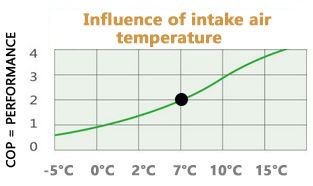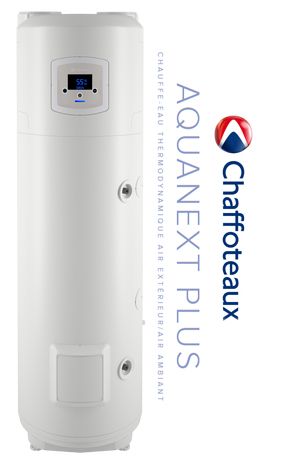Home / Domestic Hot Water Heating DHW / Thermodynamic storage water heater (español – français)
When should you choose a heat pump water heater?
Share this page
Operating principle
The thermodynamic water heater (heat pump water heater) is a storage water heater associated with a heat pump. The calories in the air are captured and reused to heat a refrigerant fluid and then the water in the tank.
During the peak time, one-time demand and to respond more quickly to the demand, an electrical resistance built in the water heater takes over in the image of a classic tank water heater.
The COP or coefficient of performance of a heat pump water heater

The water heating is the second largest energy consumption in the dwelling (after the heating). Representing approximately 20% of energy consumptions, it is therefore not to be overlooked. The COP is a coefficient or performance, which reflects the performance between the energy consumed and the energy produced by the equipment. The “theoretical” COP (in laboratory) of the most efficient thermodynamic water heaters is between 3 and 4.
For 1 kwh of electric energy consumed, 4 kwh are theoretically produced to heat the water (depending on the air temperature that it intakes, the temperature of the water to heat, the tank volume). In practice, the COP is more between 2 and 3. It varies greatly according to the temperature of the running water and the external temperature, therefore the geographical zone.
Water heater location selection, connection logic, consequences on savings…
Everything depends on the configuration of the housing. Several scenarios can be distinguished:
- The water heater absorbs directly the ambient air. It must be placed in an unheated room (garage, basement, technical room, washroom) but thermally well insulated from the rest of the house. The room volume has to be at least of 20 m3. An evacuation of cold air must also be provided towards the outside of the house.
- The water heater absorbs the calories from the air (hot) extracted by the single flow CMV. The connection infrastructure is more complexe (when it is possible) and often has to be oversized. Indeed, in practice the CMV must be more powerful, so at the end the heating consumption might be higher, which loses much of its interest.
- The water heater absorbs the calories from the outside air. The outside air is drawn in and the cold air is released to the outside. It’s the most frequent case. The heat pump may be incorporated in the water heater (inside) or in the form of a 2 parts model, known as “split” (heat pump on the outside).
The connection logic will depend on the “compatibility” of the solution with a given type of housing. Indeed, the thermodynamic water heater is hardly compatible with an apartment life (noise, no extraction). For individual houses, the solution is less interesting as it already has a central heating which generally assures also the production of domestic hot water (DHW). The target of a thermodynamic water heater is therefore an individual house heated by electricity. The only thing you need to do is to dedicate a technical room (garage, laundry room, etc.), a little bit away from other rooms where we spent most of the time, but not too far as not to increase the energy losses related to the distance. The larger containers are placed on the floor and the smaller ones can be hung on the wall (to free up living space).
What capacity to choose for a heat pump water heater?
The capacity depends on the number of posts (washbasin, sink, shower, etc…) to be supplied and of people living in the dwelling.
- The models of 250 litres to 300 litres correspond to the needs of a family of 4-5 people (between 30 and 60 Litres of hot water at 55°C per day and per person – in average – according to the use).
- The models of over 300 litres are reserved for families of more than 6 people.
- There are 110 L models for smaller needs, for a family of 2-3 people. Warning, the real performances (COP) are reduced.
Watch out not to oversize the water heater as not to heat an unnecessary volume of water. Do not undersize as not to run out of hot water when the tank is empty.

At what target temperature should you set your heat pump water heater?
In a collective housing, the minimum is 55°C to avoid the proliferation of legionella in stagnant waters. In individual housings, we advise to meet this minimum value. Even at this temperature, the legionella is destroyed only after few hours. The market water heaters are preset at this temperature. In theory, to eliminate any health risk you need a daily thermal shock at 60°C. In sensitive collective environments, there are additional technical solutions to fight against the continued destruction of legionella (pasteurisation, etc.).
The advantages of a heat pump water heater
The thermodynamic water heater:
- allows a reduced operating cost compared to other modes of hot water production (classic electric water heater, gas water heater, etc.) in certain specified conditions. The performance (COP) and the profitability plummets if the quantity of water to consume is too low while the water heater is oversized to the needs (= the whole volume of water is heated for nothing). To take the most advantage of the performances, aim water heaters dedicated to families of 4-5-6 people (capacity of 300 Litres). For small needs, the profitability plummets.
- offers a good return on investment if the purchase cost for a 300 Litres water heater do not exceed 3000£ all taxes included (including installation), in the ideal consumption conditions. For example, for a family of 5 people who consume 80 litres of hot water per day over the year (UK average), the yearly consumption would be of 520£ (based on a COP 3 announced by the manufacturers). Compared to a traditional water heater, the gain is about 520£ per year.
- requires a relatively simple installation and connection (which requires only a single trade – plumber) in the case where the air is not drawn from the outside.
- allows tax credit under certain conditions.
- meets the criteria imposed by the thermal regulations in new buildings.
- air resulting dehumidification in the place of its location (if the air is exhausted inside).
The disadvantages of a heat pump water heater
The location of the thermodynamic water heater, its air capture mode and the outside temperature of the residential area are the key for good performances.
- Air drawn from the ambient air: cools the ambient air of the room where it is located. Therefore this room must not be heated as well as it should be thermally very well insulated from the rest of the house. Otherwise, the heating requirements will be increased. Of course, take into account the noise related disturbance when the heat pump is operating.
- Air drawn from outside of the dwelling:
- The geographical area is important. The greater the difference of temperature between the water to heat and the drawn air is, the more the efficiency of the device decreases. It is therefore to be avoided in areas where winters are long and cold (under 0°C) and to be preferred in warm areas. Reduced efficiency if the outside temperature drops under 5°C. The coefficients of performance of the manufacturers are given as an advice at an outside temperature of 7°C. The COP is strongly reduced under that limit. This equipment is suitable for areas with mild temperature. An electrical resistance (or another power source) can be activated at low temperature.
- This involves work that can create a “loophole” in the insulation of the façade.
- The noise level when the heat pump works. It should not exceed 50 decibels (dB) so as not to disturb the occupants. Note that from this threshold, an increase of only 3 decibels corresponds to double the sound intensity (and 12 dB to x 16 intensity). This criteria is therefore very important.
- If you wish to benefit from peak hours tariff, it will have to operate during the night when the air is generally cooler (ambient or outside air). Its performance will therefore be reduced. It will have to be insulated from the rest of the dwelling in order to limit the nighttime noise disturbance.
To know more: Comparison of an electric and a heat pump water heater
The latest innovations in terms of a heat pump water heater
The main innovations are:
- Limiting the noise level during operation.
- Using more eco-friendly fluids.
- Reducing the heating time for the whole or part of the tank volume in order not to run out of hot water. Particularly when the outside temperature is low.
- Improving the performances (COP) to operate effectively even at low outside temperatures.
- Coupling in mixed multi-system solutions (for example a condensing boiler + heat pump water heater or solar panels + heat pump water heater).
- Reducing the size.
- Maintenance without draining the tank.
- The insulation of the tanks to make them as heat-proofed as possible. Protection against corrosion.
Innovative Companies of Heat Pump Water Heaters
VIESSMANN

The French company VIESSMANN is one the world’s leading manufacturer of heating and cooling systems. This 12 000 people company, in more than 70 countries, develops especially DHW domestic hot water production systems with their innovative and efficient heat pump water heaters.
CHAFFOTEAUX

The French company CHAFFOTEAUX offers multi-energy heating systems as well as innovative and energy-efficient domestic hot water production systems with reduced noise levels (52 dB).
ARISTON

The Italian company ARISTON offers DHW domestic hot water production systems with their innovative and efficient heat pump water heaters. Short heating time.
To know more: discover the latest innovations of leading companies in the domain of heat pump water heaters
FOX24


